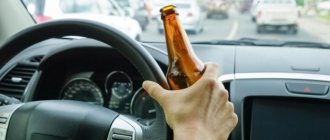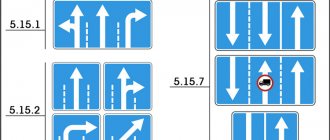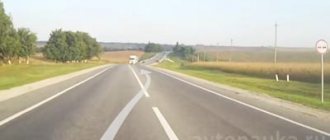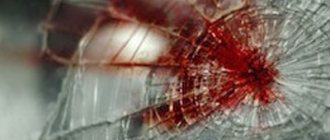Home / Vehicles
Back
Published: 04/10/2020
Reading time: 2 min
0
589
- Hello. Is there a clause in the Rules of the Road that prohibits overtaking or avoiding obstacles if the vehicle in front is overtaking or avoiding the obstacle? Does “overtaking a train” threaten with deprivation of your license? Which car is prohibited from overtaking according to the rules: the one that is overtaking, or the one being overtaken?
- What do the Traffic Rules say about overtaking a train?
- Is it possible to overtake with a train?
- Responsibility for non-compliance with the rules
Understanding the concepts
Before you announce the fine for overtaking a train, as well as for double overtaking, you should understand what this means.
Double overtaking is considered to be overtaking 2 or more vehicles by driving into the oncoming lane. That is, during such a maneuver, having gotten ahead of the first car, the driver does not return to his part of the road. Or overtaking a car that is overtaking at that moment is considered as such.
But there is also the concept of being overtaken by a train. Also called gooseneck. In this case, you drive into the oncoming lane behind the car that is overtaking. At this moment, there are 2 or more cars on the opposite side of the road.
There is a whole section in the current traffic regulations regarding overtaking. All the rules for safe maneuvers, existing prohibitions, as well as the conditions under which overtaking is possible are spelled out here.
The punishment does not follow for the fact of overtaking. The question here is about entering someone else's lane.
Yes, in theory, when overtaking you always need to drive into oncoming traffic. But not always, when driving into the oncoming lane, the driver overtakes. Sometimes this is an advance, as in the case of overtaking slow-moving vehicles, which were already discussed earlier.
And overtaking in dangerous turns is always prohibited. There are no conditions that allow such an action to be performed without violating the rules.
What does the traffic regulations say?
According to paragraph 11 of the current rules, before starting the maneuver, the driver must make sure that the oncoming lane is clear for exit, and he will not create obstacles for other members of the road traffic.
The term “double overtaking” does not exist in the traffic rules.
It says that drivers are not allowed to overtake a vehicle in front of them in the following cases:
- if it itself overtakes, as well as avoids obstacles;
- the car in front turned on the left turn signal and began to drive out to get ahead of the car driving in front of it;
- the vehicle behind him began to overtake;
- it will be impossible to complete the maneuver without interfering with the overtaken vehicle.
The driver of the car in front should not create difficulties for overtaking, in particular, increase the speed.
In addition, double overtaking will be prohibited in the same cases as regular overtaking, namely:
- if it occurs at a controlled intersection, when driving on a secondary road at uncontrolled intersections;
- at designated pedestrian crossings;
- when approaching railway crossings, starting from one hundred meters or less;
- in tunnels, when a car completes a steep climb, during a dangerous turn, in an area of reduced visibility.
If oncoming traffic on the road is difficult, the driver on the side where this obstacle is located must yield. In the presence of signs “steep descent” or “steep climb”, the car moving downhill gives way.
Let's talk about double overtaking
The traffic rules contain prohibitions and regulations regarding such a maneuver. It turns out that when there are no prohibitions, then it is allowed.
The current traffic regulations for 2021 do not contain any clauses prohibiting double overtaking. Moreover, regardless of the number of vehicles taking part in such a maneuver.
There is only one condition. Drivers are required to make sure in advance that their actions will not entail any dangerous consequences. That is, the maneuver is safe.
The conclusion about whether a maneuver is safe depends on the consequences. If no accident occurred, then everything was done according to the rules. If an accident occurs, you will have to pay a fine or lose your license.
But clarifications need to be made. According to traffic rules, when performing the action in question, drivers are required to check several points:
- there are no cars in the oncoming lane, or they are at a sufficient distance to have time to complete the maneuver;
- there is no continuous dividing strip ahead;
- there is no sign prohibiting overtaking;
- there is no overpass, pedestrian zone, or railway crossing;
- the same applies to tunnels, overpasses, dangerous turns and climbs;
- at that moment the car behind did not overtake your vehicle;
- None of the cars in front activated their left turn signal.
This list fully defines the conditions under which it is and is not possible to overtake and enter the oncoming part of the road. The same applies to the double type of maneuver.
Overtaking by a “locomotive”: prohibited or allowed?
It should be noted right away that the set of road transport rules for 2019 does not have any prohibitions regarding double overtaking. But it is important to remember that performing any dangerous actions on the road entails danger not only for the driver, but also for all road users, passengers and cargo. Such maneuvers are carried out at the driver's own risk. Before overtaking, you must make sure that the driver’s actions are completely safe. In the event of an accident, responsibility falls entirely on the driver who double overtook, because if an accident occurred, the safety of this maneuver was not assessed.
Now about overtaking by a train
Here the situation is somewhat different. And it needs to be considered separately.
Let us remember that here we are talking about a maneuver in which your car and at least one other car began to overtake another car, moving one after another. A kind of column.
Plus, there is the concept of overtaking a car that is already overtaking. Imagine the situation. There is a slow car in the lane ahead. You are moving faster. On the left side, the front car began to overtake other vehicles. At this moment, you also pressed the gas, turned left, turning on the turn signal. And now the most important thing. You drive out even further to the left of the car that has started to overtake. And as a result, go around 2 cars at once, one of which also overtakes the other vehicle. It may sound a little confusing, but everything should be clear.
And such a maneuver is considered prohibited.
There are just some nuances. Such an action in the form of a train or a jib is prohibited only by the machine that created the similar effect. That is, there is conditionally the first car that turned on the turn signal and pressed the gas. If all the conditions described above are met, such actions are not considered a violation.
But if there is a line behind this car, and they also turn on the turn signals and press the gas, then the effect of a train is already created. All cars behind you are breaking the rules.
The difficulty is that proving your innocence, even if your vehicle was the first in the created locomotive, is problematic. The only compelling argument will be the video recording from the recorder.
Clause 11.2 of the current rules states that drivers are not allowed to overtake if:
- the vehicle in front is overtaking or driving around an obstacle;
- the car behind began an overtaking maneuver.
It turns out the following. The inspector saw that your vehicle was in front of the conditional column (train). In theory, it's not your fault. But this is in theory. In practice, the inspector could not see that you did not enter the oncoming lane at the moment when another vehicle had already entered the maneuver.
Taking this into account, it is not at all impossible that a driver who seems to be acting within the rules will not be fined or will not be attempted to have his license revoked.
"Locomotive": is it possible to overtake like that?
This kind of advance refers to a method in which a car overtakes several other vehicles at once. However, besides this interpretation of overtaking by a “locomotive”, there is another one. It consists in overtaking a car that is itself overtaking. The car continues to move in the oncoming lane without returning to its own.
This type of detour is not permitted. But this rule only applies to those who are the second or subsequent overtakers. It is possible to prove that the driver did not commit a traffic violation if there is video evidence of the violation. The ban on overtaking by a train is specified in clause 11.2 of the rules of the Russian Federation DD.
Even if a traffic police representative notices the driver moving ahead of other vehicles, this will not mean that the owner of the first vehicle drove into the oncoming lane first.
There is one more subtlety in this rule, which can be called a flaw. There is a fragment in the rules that prohibits overtaking an already overtaking vehicle at any distance. It’s worth imagining the situation: a steppe road, high visibility, but a motorist has no right to overtake someone, since there is already another overtaking person.
Even if the cars are separated by 10-15 kilometers. You cannot overtake even if there are no vehicles moving towards the driver. Obviously, such a clause was added to prohibit overtaking by a train. However, in the case of the steppe route, such a situation is not even discussed. A traffic police officer can easily revoke a driver's license if he sees someone overtaking in such a situation. During the proceedings, the judicial authority will not take into account that this rule was developed to prevent overtaking by the “locomotive”.
Thus, the motorist should take into account that double overtaking is allowed this year. You cannot get ahead of yourself with a “locomotive”; this prohibition is dictated by 2 traffic rules at once.
Possible penalties
See also
Kung trailer: what they are, characteristics, how to make it yourself
Reminds that there are no penalties for overtaking actions as such. And it doesn’t matter whether it’s a double or a train.
The fact is different. Any such action is often interpreted according to Part 4 of 12.15 of the Administrative Code. And here we are talking about a fine or deprivation of rights for driving into the oncoming part of the road in violation of the rules. There is also an article following it, where the punishment will be much more serious.
As a result, there are 3 possible punishment options. It all depends on the specific situation:
- The driver drove into the oncoming lane, violating traffic rules. Interpreted according to Part 4 of Article 12.15. Here, at best, you will have to give 5 thousand rubles to the state treasury. In the worst case, the driver will find himself without a license for a period of 4 to 6 months;
- The motorist repeatedly violated the previous rule. In theory, you can pay 5 thousand rubles again. But provided that the violation was recorded using a special camera. But there is a more unpleasant outcome. This is deprivation of a certificate. Only now for 1 year;
- The driver was forced to drive onto the oncoming side of the road to avoid the obstacle. And no one will worry that the side of the road on which the driver should eat turned out to be unsuitable for this. Or some other obstacle has arisen. If you left, then be kind enough to pay from 1 to 1.5 thousand rubles.
Now you know about possible liability.
Yes, if the inspector or traffic cameras did not record a violation, then it would be as if it never happened. But this is not a reason to make downright dangerous maneuvers.
Overtaking with a “locomotive”: how to avoid getting your license revoked
Agree, it’s a common thing! You are tired after a hard week and are in a hurry to go to the countryside. The car ahead, waiting for the intermittent median strip to appear, turns on the left turn signal and begins to overtake the truck. You line up behind it and make the maneuver safely, since the area is clearly visible and there is no oncoming traffic. You return to your lane through the broken line and... fall into the clutches of an inspector who showers you with a cold shower. It turns out that overtaking will cost you the loss of your license. But how? After all, it would seem that you did not violate anything - the markings allowed, and there were no intersections on your way. Alas, such cases occur and baffle not only recent driving school graduates, but also drivers with extensive experience, because an ordinary and completely standard situation, as it turns out, can turn you into a pedestrian for up to six months. We suggest holding back the explanations that “we’ve been like this all our lives, our fathers and grandfathers...” and act strictly according to the letter of the law.
Traffic police officers are appealing for a violation of the first paragraph of clause 11.2 of the Traffic Rules, which lists violations of the rules of overtaking, namely: “The driver is prohibited from overtaking in cases where the vehicle moving in front is overtaking or going around an obstacle.” The punishment, according to them, is defined in part 4 of Article 12.14 of the Code of Administrative Offenses of the Russian Federation: “Driving, in violation of the Traffic Rules, into a lane intended for oncoming traffic, or onto tram tracks in the opposite direction, entails the imposition of an administrative fine in the amount of five thousand rubles or deprivation of the right to drive vehicles.” funds for a period of four to six months.” However, sometimes the inspectors' reasoning is astonishing.
Here is a fragment of a message from one motorist who witnessed a similar situation last summer: “We are driving along the highway, I begin to overtake, the car following me also begins to overtake, we overtook and returned to our lane in the same order. In general, the most ordinary ordinary situation on the highway... Immediately the second car is stopped by a valiant traffic police warrant officer with two trainees and charged with the following - overtaking by a train, imprisonment for 4-6 months! We started arguing with them, they showed the article of violation (Article 11.2.). We say - show me the punishment (because I have never heard of anyone being deprived of money for “little train”). The intern spent a long time delving into his book, and in the end, after 10 minutes, he showed a line with a penalty of deprivation/fine of 5 thousand rubles, but Article 11.2 was not there. He motivated this by the fact that “well, they probably didn’t write it in.”
Interestingly, there is no consensus on this issue on the Internet. Some resources trying to get to the bottom of the truth claim that a maneuver, even if it contradicts traffic rules, cannot be qualified under part 4 of Article 12.15 of the Code of Administrative Offences, while others insist on the legality and fairness of the punishment.
For clarification, we turned to auto expert and lawyer Sergei Smirnov. Having received them, we were once again amazed at the dexterity of the traffic cops, who were so good at attracting violations under articles that were not related to a specific situation. “The rules of the road stipulate the procedure for overtaking. So, before overtaking, we must make sure that the oncoming lane is clear at a sufficient distance and our maneuver will be safe (clause 11.1 of the traffic rules). In addition, paragraph 11.2 of the Rules establishes a ban on overtaking if a vehicle in front performs such a maneuver. This means that we can overtake only if there are no oncoming cars at a safe distance and none of the passing cars are overtaking. Based on this, overtaking with a “locomotive” will be contrary to traffic regulations. However, in this situation it is impossible to punish under Part 4 of Article 12.15 of the Code of Administrative Offenses of the Russian Federation. The fact is that such a punishment threatens for driving into oncoming traffic, in violation of the Rules. Here, it is not formally prohibited to enter the oncoming lane (markings allow). However, you cannot overtake, since the other car has already started this maneuver. In other words, paragraph 11.2 specifies the circumstances in which we cannot overtake. It turns out that the legislator did not provide for direct punishment for such an offense,” the expert told us.
Another thing is that overtaking a “locomotive” is sometimes fraught with risks - on the Internet there are many frightening videos from dashcams of how a car overtaking second or third does not have time to safely complete the maneuver. But now we are talking about something else. Don’t allow yourself to be fooled and be prepared for a discussion like in one Russian film: “This is not an article yet, but we’ll add it to the article.”









